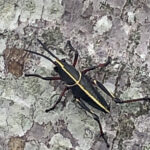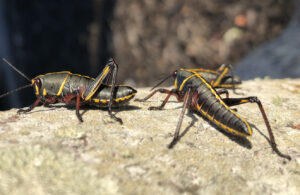Note: All links below go to external sites.
Greetings, BugFans,
When BugFan Mary sent “what-is-it?” pictures from Florida of this wildly handsome grasshopper nymph, the BugLady said “More, please,” sending Mary back out into the palmettos to stalk grasshoppers with her Smartphone. Thanks, Mary!!! With luck, the neighbors weren’t watching.
This is one serious grasshopper! It’s hard to ignore a grasshopper that’s large enough to trip over and too large to fly.
Big grasshopper? Big story. Put your feet up.
 Lubber grasshoppers are in the family Romaleidae, a family that’s having a taxonomic “Pardon our Dust” moment because some experts suspect that a few of the genera now included may not belong there. One reputable source lists only four species north of the Rio Grande, but Bugguide.net includes nine species in seven genera. Even the star of today’s show can be found under two scientific names – Romalea microptera and Romalea guttata.
Lubber grasshoppers are in the family Romaleidae, a family that’s having a taxonomic “Pardon our Dust” moment because some experts suspect that a few of the genera now included may not belong there. One reputable source lists only four species north of the Rio Grande, but Bugguide.net includes nine species in seven genera. Even the star of today’s show can be found under two scientific names – Romalea microptera and Romalea guttata.
Quick Etymological Detour: Romaleidae comes from a New Latin word that’s based on a Greek word that means, appropriately, “strong of body.” The word “lubber” (which rhymes with “blubber”) has negative connotations in a variety of languages – “lazy or clumsy (Old English), “plump and lazy” (Swedish), “clumsy and stupid” (other Scandinavians), “swindler and parasite” (Old French), and “bumpkin.” Microptera means “micro wing” and guttata means “spotted.”
[“Lubber” – a deeper dive: According to https://www.etymonline.com/word/lubber, “’Since 16c. mainly a sailors’ word for those inept or inexperienced at sea (as in ‘landlubber,’ but earliest attested use is of lazy monks (abbey-lubber). Compare also provincial English lubberwort, name of the mythical herb that produces laziness (1540s), Lubberland ‘imaginary land of plenty without work’ (1590s).” Lubber is also a verb – “to sail clumsily; to loaf about,” 1520s, from lubber(n.).”]
Anyway, there are some pretty spiffy North American lubber grasshoppers, not all of which are super-sized and not all of which are flightless, including the aptly-named Dragon lubber, the Robust lubber, and the awesome Horse lubber and https://bugguide.net/node/view/845442 (Arizona Road Trip!).
An eye-catching insect like this is bound to have lots of common names. Along with Eastern lubber grasshopper, it answers to Florida lubber, Southern lubber, Texas grasshopper, graveyard grasshopper, soldier boys, Georgia thumper, and devil’s horse.
It’s the only lubber in the East, and one author calls it an insect of the deep, deep South. Look for it in the Southeastern US from East Texas around the Gulf Coast to Florida, north to North Carolina, and west to Tennessee and Missouri. Because they’re flightless, they aren’t spread evenly within that range. Adults prefer dryer habitats in pine woods and weedy fields, and nymphs like swamps, marshes, wet pastures, and ditches.
Males grow to 2 ½ inches and females to 3+ inches https://bugguide.net/node/view/212661. Part of bugguide.net’s description reads “Distinguished by huge size and vivid yellow/red/black coloration, with hind wings red bordered black.” There’s a lot of variation in color
- https://bugguide.net/node/view/585300
- https://bugguide.net/node/view/1330153/bgimage
- https://bugguide.net/node/view/1264792/bgimage
and some color schemes get established regionally (the black morph is more common around the Gulf Coast). Newly hatched, and newly-molted lubber nymphs are red, but they darken quickly.
There’s only one generation per year. Guarded by a male, the female lays eggs in summer, depositing about three pods, each containing 30 to 50 eggs, an inch or two underground in easily-excavated soil (she digs a hole with the tip of her abdomen). Each pod is plugged with a foamy cap that allows the nymphs to escape when they hatch. The eggs overwinter and the nymphs emerge in late winter as air and soil warm. Dramatic migrations of lubbers-on-the-hoof have been reported – some associated with overcrowded nymphs seeking food, and others associated with adults seeking romance.
Sources are divided about whether lubbers are a big agricultural pest or not. They feed on about 100 different herbaceous and woody plants in 38 plant families, and unfortunately, their menu includes some thick-leaved ornamentals like amaryllis, a few fruit trees (including citrus), and some vegetable crops (they like peas, beans, kale, and cabbage but not eggplant, tomato, pepper celery, or sweet corn). There’s evidence that they can locate food plants by detecting their odors on the wind. Though flightless, lubbers are good climbers; their usual MO is to chew holes in leaves and move on, but the nymphs are gregarious, and a dedicated gang of nymphs can defoliate a branch https://bugguide.net/node/view/43432/bgimage.
Nymphs also eat emergent aquatic vegetation in ditches, including some unwanted weeds, before they move into farm fields, and adults eat less than you’d think an insect of that size would eat. On the plus side, an ingredient in a lubber’s saliva stimulates plant growth and can make a plant that’s rebounding from grasshopper foraging bushier and more desirable to four-legged-grazers (“compensatory plant growth”).
Not much preys on Eastern lubbers. Their bright (aposematic/warning) colors signal to predators that eating them would be a bad idea, and when something does try to make a meal of them, they launch a three-pronged attack – structural, behavioral, and chemical. Seems like overkill, but remember, these guys are heavy and slow and flightless, and they don’t even hop well.
An alarmed lubber first flares its wings, a strategy that’s especially effective with birds. If that doesn’t work, it releases toxins. Lubbers sequester some poisonous chemicals from the leaves they eat, and they synthesize others, and these chemicals come out of the spiracles (breathing tubes) of the thorax, first (with a hiss) as a noxious spray that can carry as far as 6 inches, and then as a foam that bubbles out (scroll down https://academic.oup.com/jipm/article/9/1/10/4938808). Like other grasshoppers, it may also vomit “tobacco juice” – a fluid that’s made of recently eaten plant material and that may be repellent in itself (especially to ants) if the grasshopper has been dining on toxic plants.
The array of plants that lubbers eat allows them to stockpile different chemicals at different times, and their predators can’t get acclimated to the poisons because the ingredients are always changing. The chemicals deter invertebrates and vertebrates alike – frogs, lizards and most birds vomit strenuously and may even die after eating one, and even opossums can’t stomach them.
The bubbly broth is stored in a gland within the thorax. In an article called “Large size as an antipredator defense,” researchers Whitman and Vincent write that “As such, this unique defense gland serves as a toxic waste dump for potentially harmful, plant secondary compounds. When ejected, these low-weight substances quickly volatize, enveloping the grasshopper in a noxious chemical cloud, deterrent to many vertebrate predators,” and they add that “It appears that lubbers have evolved to occupy a relatively predator-free ecological space: they are too large to be attacked by most invertebrate predators and too toxic for most vertebrate predators.”
They have legs that are heavily armed with spines that are sharp enough to pierce human skin, and the chitonous plates that make up their exoskeletons are extra-tough – these guys are armored tanks. They are harmless to humans, but they have strong jaws, and one bugguide.net correspondent reported being nipped smartly by a nymph that was scaling his leg.
Fun Facts about Eastern Lubber Grasshoppers
- Most people’s first (and only) contact with them comes when they dissect one in a biology class. The BugLady did so back in the ‘60’s, and she still remembers how stinky it was – a result of the synergy of the formalin preservative and the grasshopper’s special essence.
- According to a Natural History Writings entry at Loyola University’s Institute of Environmental Communication, “A popular Louisiana childhood pastime before computer games was to harness lubbers to a matchbox and pretend they were horses pulling wagons.”
- The only hungry bird that’s figured out a “work-around” is the Loggerhead Shrike, which impales a grasshopper on a thorn or barbed wire fence and then leaves. After a few days, the toxic substances have neutralized, and the bird gets a sizeable meal.
This is really a spectacular insect, and lots of people like taking pictures of it (and it poses so nicely!). Here are some gratuitous pictures from bugguide.net:
- https://bugguide.net/node/view/101967
- https://bugguide.net/node/view/1371814/bgimage
- https://bugguide.net/node/view/901444/bgimage
- https://bugguide.net/node/view/682611/bgimage
- https://bugguide.net/node/view/100841/bgimage
- https://bugguide.net/node/view/81814/bgimage
- https://bugguide.net/node/view/408028/bgimage
- https://bugguide.net/node/view/1377304/bgimage
The BugLady
